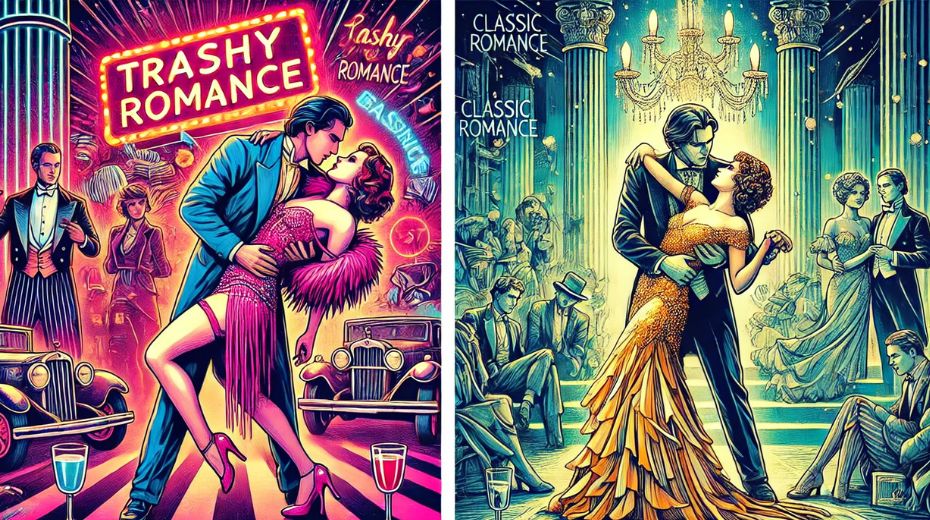What is the Difference Between Trashy Romance Novels and Classic Romance Novels?

Romance novels have captivated readers for centuries, weaving tales of love, desire, and emotional journeys. However, within this broad genre, there are distinct categories that can be challenging to navigate. Two of the most frequently discussed categories are trashy romance novels and classic romance novels. Each offers a unique experience, appealing to different reader preferences and cultural contexts. In this blog post, we’ll explore the key differences between these two types of romance literature.
Defining Trashy Romance Novels
Trashy romance novels, often characterized by their sensational plots and steamy scenes, tend to prioritize entertainment over literary merit. These novels often include:
- Predictable Plots: Many trashy romance novels follow a formulaic structure. The love story typically revolves around a handsome stranger and a naive protagonist, leading to a whirlwind romance filled with misunderstandings and reconciliations.
- Explicit Content: As the name suggests, trashy romance novels frequently include graphic sexual scenes. While some readers appreciate this aspect for its escapism, others critique it for overshadowing character development and plot depth.
- Clichéd Characters: Characters in trashy romance novels can often fall into stereotypical roles, such as the brooding billionaire or the innocent small-town girl. This predictability can lead to a lack of emotional investment for some readers.
- Easy to Read: These novels are often seen as light reads, making them popular choices for beach vacations or quick getaways. The writing style is generally straightforward, making it easy for readers to immerse themselves in the story without needing to engage deeply with complex themes.
While some might dismiss trashy romance novels as mere fluff, they undeniably serve a purpose. They provide escapism and entertainment, allowing readers to indulge in fantastical scenarios and passionate encounters.
Understanding Classic Romance Novels
In contrast, classic romance novels often strive for a deeper exploration of love and relationships. They are marked by:
- Rich Character Development: Classic romance novels focus on character growth and emotional depth. The protagonists often undergo significant personal transformations, making their love stories feel more authentic and relatable.
- Complex Themes: These novels tackle serious issues such as societal norms, personal sacrifice, and the consequences of love. Authors like Jane Austen and the Brontë sisters explored the intricacies of relationships within the context of their societal frameworks, giving readers much to ponder.
- Subtlety in Romance: Instead of relying solely on explicit scenes, classic romance novels often build tension through dialogue, emotional connection, and slow-burning attraction. The romance develops over time, creating a sense of anticipation and emotional investment.
- Timeless Appeal: Many classic romance novels have endured through the ages, remaining relevant due to their exploration of universal themes. Their insights into human relationships resonate with readers across generations, making them staples in literary discussions.
Classic romance novels challenge readers to reflect on love’s complexities and the societal influences that shape relationships. They often evoke a sense of nostalgia, bringing readers back to the enduring struggles and joys of romance.
Comparing Trashy and Classic Romance Novels
While both trashy and classic romance novels serve the purpose of entertaining readers, their methods and impacts differ significantly. Here are some key comparisons:
Purpose and Audience
- Target Audience: Trashy romance novels often target readers seeking quick, entertaining escapism. Conversely, classic romance novels tend to attract those looking for deeper reflections on love and society, appealing to literary enthusiasts who appreciate nuanced storytelling.
- Reader Expectations: Readers of trashy romance novels often expect fun and adventure, while those drawn to classic romance anticipate a more profound exploration of characters and their emotional journeys.
Themes and Motifs
- Romantic Focus: Trashy romance novels frequently emphasize physical attraction and immediate chemistry, while classic romance novels often explore the evolution of emotional connections and the complexities of love.
- Cultural Commentary: Classic romance novels often critique societal norms and expectations, whereas trashy romance novels typically focus on individual desires without delving deeply into broader cultural implications.
Literary Value
- Depth of Writing: Classic romance novels usually exhibit a higher degree of literary craftsmanship, employing rich language and sophisticated narrative techniques. In contrast, trashy romance novels prioritize accessibility and entertainment, often at the expense of literary depth.
- Longevity: While trashy romance novels can be incredibly popular in the moment, classic romance novels tend to have lasting power, being revisited and studied in literary contexts for their insights into human nature and relationships.
In the world of romance literature, both trashy romance novels and classic romance novels hold their own appeal. Trashy novels offer a light-hearted escape, while classic novels invite readers to engage with more profound themes. Ultimately, the choice between the two comes down to personal preference. Whether you’re in the mood for an exhilarating adventure or a thoughtful exploration of love, the romance genre has something for everyone. So, the next time you pick up a romance books, consider what you’re looking for—a bit of fun or a deeper dive into the human heart.